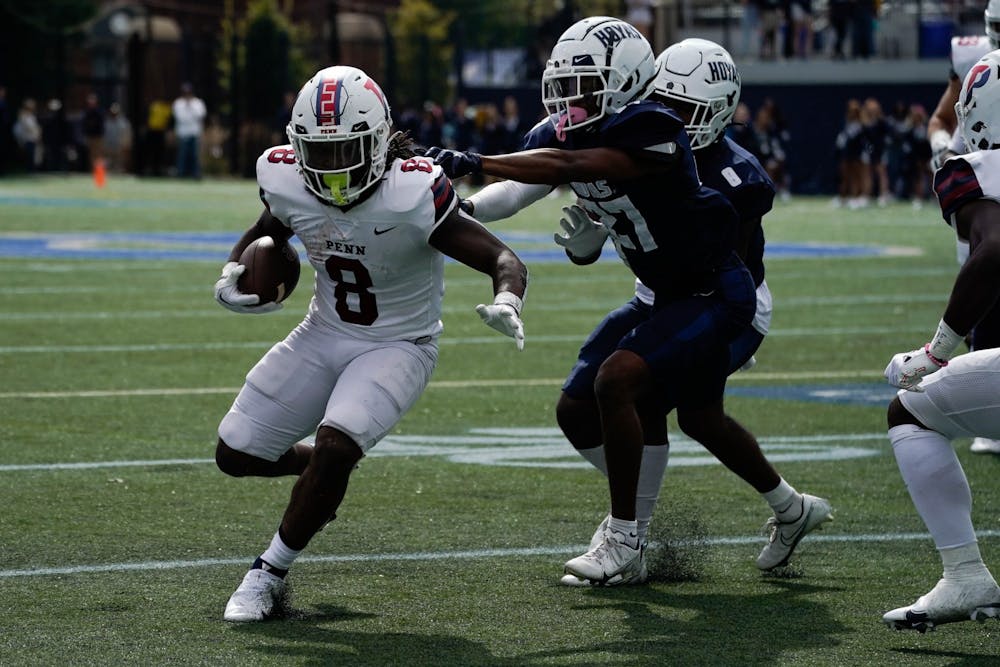
WASHINGTON, D.C. — There are caveats, to be sure. But on Saturday at Georgetown, Penn football’s offense finally showed signs of life — and suggested that the defense might not have to be the unit carrying the team all season.
During Penn’s prior two games, the Quakers scored 12 and 10 points, respectively, excluding the two overtimes at Dartmouth. The team sat at a comfortable 3-0, but the offense looked shaky, unreliable, and poised to cost Penn as the season wore on.
On Saturday, however, the Red and Blue’s offensive attack finally sparked, totaling 59 points on the road at Georgetown, the most Penn has scored in a single game since September of 2017.
Senior running back Trey Flowers ran for 149 yards — the most in a single game in his career — and two touchdowns. Twice, the Miami native broke through multiple Georgetown defenders to plow for massive gains, chugging for 40 and 38 yards on different plays. The offensive line opened up lanes for the senior all day, while Flowers was also able to rush outside the tackles on several occasions for big carries.
Meanwhile, sophomore quarterback Aidan Sayin had arguably the best day of his young career, finding four different receivers for touchdowns and running one in for himself. Though there were a couple of overthrows, Sayin was mostly accurate, favoring safe, short routes that his receivers took for an impressive 154 yards after catch.
The caveat though — in their last four games, the Hoyas have given up 45, 42, 59, and 59 points again. Their defense has been atrocious as of late, and Penn did an effective job capitalizing on it. Whether or not that success translates to higher-caliber Ivy League defensive fronts remains to be seen.
Penn’s defense was also critical in providing the offense with opportunities to score, as five of the team’s eight touchdowns came on drives where the Quakers started in Georgetown territory.
While the Hoya defense is the especially susceptible unit on the team, their offense isn’t much better, finishing two of their three games prior to Saturday with exactly six points. Opponent quality aside, the Quaker defense held firm against Georgetown, allowing just two touchdowns, one of which came after a Sayin interception set the Hoyas up inside Penn’s 40.
Georgetown finished with 28 points, though, thanks to two kickoff return touchdowns by freshman Mason Gudger. Special teams hasn’t been a huge area of note in Penn’s first three games, but after Saturday’s performance, it could become a concern.
All issues aside, Penn’s unsurprising win after entering as double-digit favorites marks an important milestone for the team. Last season, the Quakers went 3-7, and with the victory on Saturday, they’ve now topped that total with four wins through the first four games.
Three have been non-conference, but Penn’s win over reigning Ivy co-champion Dartmouth proved that this is a vastly superior team to the one it had last year, and the 4-0 start is an encouraging sign for a program that hasn’t won an Ivy title since 2016.
There were a lot of question marks hanging around the team going into this year, with a new offensive coordinator and a sophomore quarterback that had just five games of experience. And though Penn has managed wins every game, not all of those questions were answered, as the offense has still struggled.
Penn averaged an Ivy-worst 19.1 points per game last season. In the first three games of this year’s campaign, the Quakers averaged exactly 20.0, thanks in large part to 13 points across two overtimes at Dartmouth, without which Penn would have been at a 15.7 points-per-game average.
The Quakers’ 59 points at Georgetown doesn’t outright quell those concerns — caveats abound – but the performance at least suggests that the offense has the potential to not be a total weak spot.
MATTHEW FRANK is a Senior Sports Editor for The Daily Pennsylvanian and is a College junior from Miami studying English. He can be reached at frank@thedp.com.
The Daily Pennsylvanian is an independent, student-run newspaper. Please consider making a donation to support the coverage that shapes the University. Your generosity ensures a future of strong journalism at Penn.
Donate






